Last week we had to take an impromptu overnight trip to Austin. Because Steve
had things that he needed to keep up with email-wise, he brought along mini-me,
my aging Fujitsu P2110. The battery on that laptop is not holding much of a
charge anymore, but he figured it would last for at least an hour or two using
the hotel’s wireless. Well, after about 30 minutes the battery went from 3/4
charge to gasping for breath – and Steve was starting to panic. Luckily for him,
I had brought along the Tekkeon
myPowerALL
Universal Rechargeable Battery with the hopes that we could try it out.
Because of the myPower, Steve was able to use the computer for several hours
with plenty of backup power to spare.
Unlike other
universal charging cables that I have reviewed in the past, the myPower does not need to be plugged into the wall while supplying power to an electronic device,
because the myPowerALL is its own great big rechargeable battery. Once it
has been fully charged, which takes approximately 4 hours from empty, the
myPower becomes a standalone power source and charger that can be easily carried
in the user’s gear bag or larger purse.
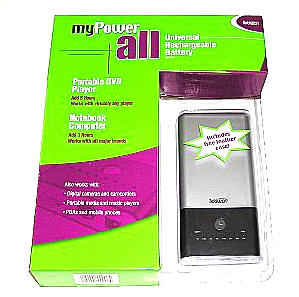
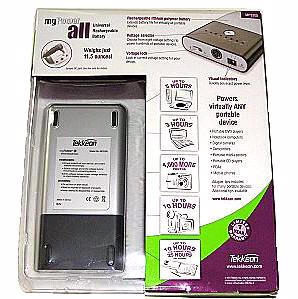
Inside the package is the myPowerALL, a leather travel case with belt loop,
the power adapter, a power output cord, an adapter plug kit with eight tips
(kept tidy in a drawstring bag), and the user guide.
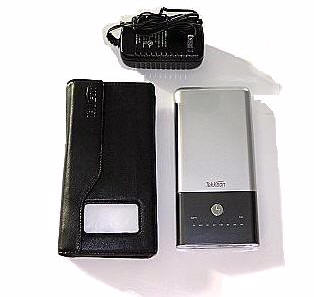
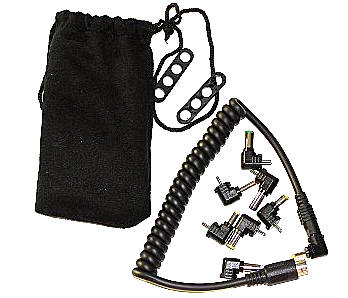
According to the Tekkeon website, the following approximate times can be
expected for various devices:
| Portable Device | Approximate Usage |
| Portable DVD player | 5 hrs |
| Notebook computer | 3 hrs |
| Digital camera | 4,000 photos or 9 hrs |
| Camcorder | 10 hrs |
| Portable media center | 10 hrs of video/25 hrs of audio |
| MP3 player (HD based) | 100 hrs |
| Portable CD player | 80 hrs |
| PDA | 12 hrs |
| Mobile phone | 50 hrs of talk time |
The myPowerALL measures approximately 7" long x 3.25" wide x 0.75" thick and
weighs 12.0 ounces. Its body is composed of black and matte silver plastic with
chrome accents. It has a very solid feel, and when squeezed or flexed there is
very little creaking.
Let’s take a look at the buttons and switches on the device…
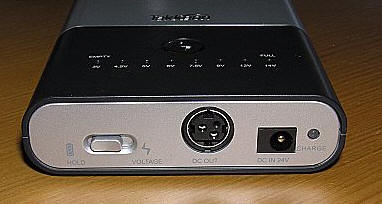
The front has (from left to right): the hold / voltage sliding lock, the DC
OUT port, the DC IN port and the LED indicator light.
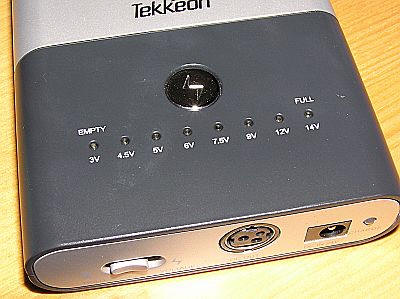
The top of the device has a series of eight red LED lights that are labeled
incrementally from EMPTY / 3V to FULL / 14V. A round silver button on the top
operates as the voltage selector.
The first time that the myPower is charged, it should be allowed to go a full
four hours. While charging, the LED light next to the DC IN port will glow red
until the the battery is 80% charged, at which time the LED will turn green.
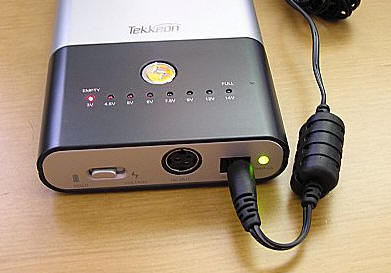
So obviously just because the LED has turned green, it doesn’t necessarily
mean that the device is fully charged. Testing for a full charge is done in the
following manner: with the myPower plugged in to the wall and connected to the
DC IN port and with the sliding lock set to HOLD, or with the the silver voltage
battery on top must be pressed. The line of green LEDs will light up displaying
the increment of charge, with all glowing green once the battery is full, like
this:
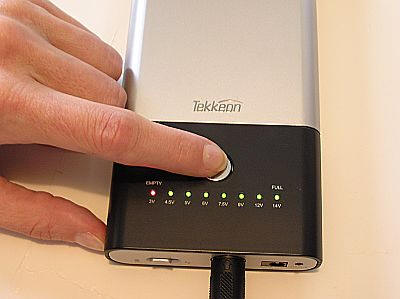
The myPower fits nicely into the leather travel case, and there are cutouts
on the front and top so that all of its features on the top and front are visible.
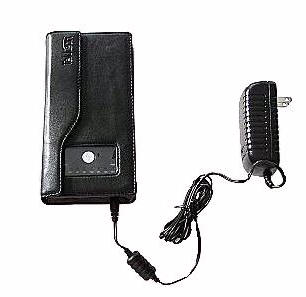
I am very interested in bringing the myPowerALL along on our upcoming trip to
the UK, I hope to be able to use it as my iPAQ’s backup charger and power source
on the plane. Can you tell that I am one of those people who never
manages to get a seat with a power port? Hopefully because of this gizmo I won’t
even care anymore.
The myPowerALL will work with just about any electronic item that uses 14V or
under and that has a circular power jack; but this power jack is the key.
The following picture shows the type plug that the myPowerALL uses, so
obviously there will need to be either a round power port on the device to
accept the plug, or an adapter available for the device that can accept a round
power plug. Most devices like laptops, portable DVD players and portable music
players will typically have this round DC plug port. If you happen to own a
device that has a crazy adapter plug and there is no round DC adapter available,
then the myPowerALL will not work with your item.
Assuming that your device can use the round DC tip either on its own or with
an adapter, let us proceed…
Since the iPAQ has a crazy looking power port, I’ll have to use the DC
adapter plug it came with in addition to one of the myPower’s included adapter
tips. Today, while writing this review, will be the first time I have ever used
the myPower with my iPAQ. I figured we could give it a try together. :0)
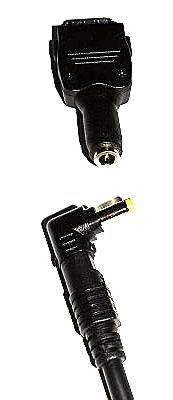
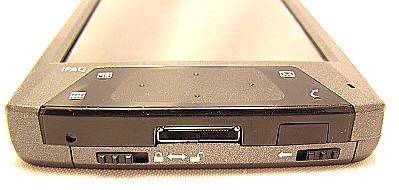
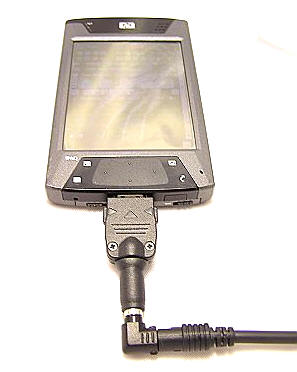
From left to right: myPowerALL’s round power plug with the
iPAQ adapter tip, the irregular PAQ power port, the myPowerALL plug used with
the iPAQ adapter in the iPAQ’s power port
The electronic item’s necessary voltage can be determined by flipping it over
and looking at its specification label. This is what the label on the back of my
iPAQ looks like…
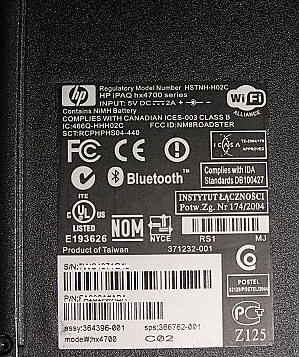
…and here is a close-up showing the information I will need to select
voltage, as well as how I will need to set the polarity of the adapter tip on
the power output cable.
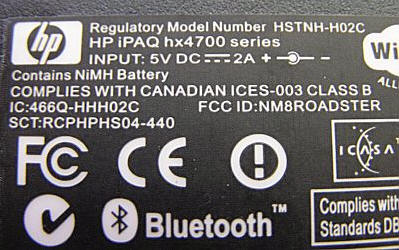
The myPower can’t be used on devices that draw more than 4Amps, and according
to the label above – my iPAQ takes 2A, so we should be good to go. It looks like
I will need to set the myPower to 5 volts, and according to the polarity symbol, the center of the adapter plug should be positive. I had already sorted through
the adapter tips and found the one that best fit into the iPAQ’s adapter. You
can also save some guesswork by using the
reference guide
on the Tekkeon website. If one of your devices takes an adapter tip that is
not one of the included eight, then it can be purchased for a nominal fee.
My iPAQ 4700 isn’t specifically listed as a compatible device, but according
to the Tekkeon website, "The adapters that fit a majority of the jack types
are included with myPower ALL. However, if you cannot find your specific model
in the compatibility list, but see similar models, it is likely that myPower ALL
will work with your device. You can assume that the model has not been included
in the compatibility list, as we have not yet identified the adapter type on
that specific device." HP has been kind enough not to change the iPAQ
adapter for some time, so I was confident that everything would be fine for my
model.
The power output cable is marked with a + and – sign on each side of its end.
The device’s polarity, either positive or negative, will
determine which way the adapter tip should be plugged in. For a positive
polarity, the user will match the positive symbol on the cable to the positive
symbol on the adapter tip. For negative polarity, the positive symbol on the
cable should be matched with the negative symbol on the adapter tip.
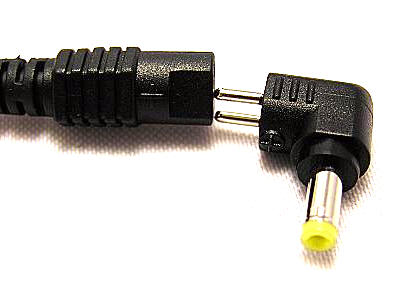
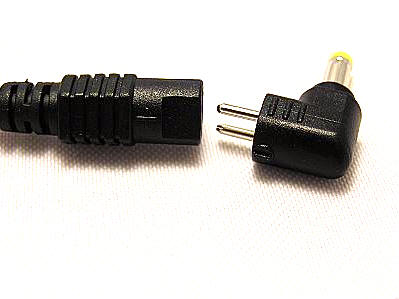
Once the tip has been installed, the power output cable should be plugged
into the myPowerALL’s DC OUT port. At this point, a red LED will light at the 3V
position. Now I have a choice: I can either charge the iPAQ by setting the
myPower to 5V, or I can run the iPAQ on a slightly less voltage which will
actually extend the length of time that the myPower will be able to power the
iPAQ.
The idea of running something on a slightly lower voltage – one strong enough
to run the item but not strong enough to charge its battery – sounded pretty
interesting to me. So in other words, one can turn off the device being charged
as the myPower works at the correct voltage, and the item’s battery will be
charged to capacity. Or, one can run the myPower at a slightly lower voltage
increment on a device with a low or dead battery, which will tap the battery of
the myPower and allow the device to continue running for additional time past
what its charged battery capacity would have been. Make sense?
Voltage selection is made by switching the sliding lock from HOLD to VOLTAGE,
and then by pressing the voltage selector button. It will start at 3V, and each
press of the button will raise it to the next marked increment. The voltage
chosen should be less than, equal to or no more than one incremental step higher
than the device’s voltage requirement. For instance, my iPAQ takes 5V, so I
started at 3, then pressed the button twice to advance through 4.5V to 5V. Then
I plugged the myPower into my iPAQ. Here you can see the screen showing "AC
Charging" on my iPAQ…
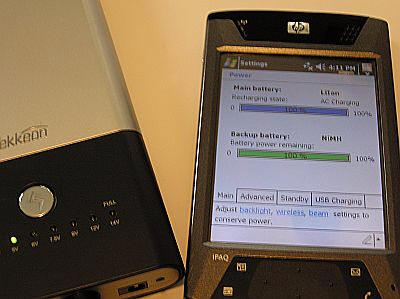
…and this is where everything started to go wrong.
When I went to pick up my iPAQ, the back of its case felt hot. This is
not something I have ever had happen, so I was concerned. I immediately
unplugged the charger from my iPAQ, at which point it’s screen went blank…as
in totally dead; lights off and nobody’s home. Thinking that maybe my iPAQ
"didn’t like" the way that I had disconnected it, I did a soft reset, and
everything came back as it usually does, appearing none the worse for the wear.
So I plugged the iPAQ back into the myPower, hoping that I could continue on
with testing. Once again I brought up the battery monitor screen, and I
immediately noticed that there was a problem. Even though the myPower was set at
5V, and even though my battery was not at 100%, the iPAQ was no longer
showing the "AC Charging" designation…and the back of my iPAQ was growing hot
again. Yikes.
I guess I am a glutton for punishment, because I didn’t stop then. I decided
that perhaps it was a fluke, so I pulled out my extended battery which I hadn’t
been using while testing. Once again, I plugged the myPower into my iPAQ, but
this time with the voltage set at 4.5. Once again I pulled up the battery
screen, but since it was not showing a charge, I decided to up the voltage to
the full 5. Still nothing…and once again, the back of my iPAQ was heating up.
So that is when I completely discontinued testing of the myPowerALL. I now had a
greater concern – I was afraid I had somehow fried my two iPAQ batteries.
Back at my desk, I plugged the iPAQ into its regular charging cable. The
active-sync music started, and I almost breathed a sigh of relief – until I
pulled up the battery screen and once again realized that it was not charging.
That’s when I decided to do a hard reset, just to make sure that nothing
internal had somehow been tripped.
After the hard reset was completed and I had restored everything from a
previous backup, I plugged the iPAQ in. Once again, it immediately begin to
sync, but it would not charge. This is when I went into analytical mode – was it
my batteries or was it my iPAQ that had been damaged?
As I mentioned, I have the iPAQ extended battery; it came with a handy
external charger which piggybacks into the regular iPAQ charge cable. This
charger will allow either the standard or extended battery to charge in tandem
with whatever battery happens to be installed in the iPAQ at the time. While I
was hard resetting and restoring the iPAQ, I had set the extended battery in the
external charger to see if it would charge. When I pulled it from my iPAQ, it
was showing at 72%. Once placed in the charger, the orange charging indicator
LED immediately began to flash, showing that it was working. After about 20
minutes, the LED was solid, indicating that the battery was fully charged. I
left the battery in its tray as I plugged in the iPAQ to sync, and suddenly the
charger’s orange indicator LED went out.
It was crazy – if I unplugged the iPAQ, the external charger’s light would
come back on – if I plugged in the iPAQ, the light went off.
After syncing was complete, I swapped batteries, and sure enough – the
extended battery read 100%, but when the iPAQ was plugged in it would not charge
and it once again started to grow hot. I then plugged the standard battery into
the external charger, and it too began to charge – unless I plugged the iPAQ in,
at which point the orange LED would once again go out.
After a while, the standard battery was charged and when I put it into the
iPAQ, it also read 100%, but it would still not charge through the iPAQ. The
point of all of this was to find out if it was my iPAQ or my batteries that was
damaged, and by now it appeared that the problem was with my iPAQ. By this point
I was honestly trying not to panic.
So I called Julie and unloaded everything on her, told her what it was doing,
what I had tried…and generally tried to pick her brain to see if she could
think of anything I hadn’t. She immediately asked if the iPAQ’s orange LED
charging indicator was coming on, and that was the first time that I realized it
wasn’t.
At this point Julie offered to call our contact at Tekkeon, and I was more
than happy for her to do so. She described the problem I was having as I IM’d
answers to any questions that arose. They could not figure out what might have
caused my iPAQ’s failure, so they suggested that I send the myPower back to them
for testing.
I couldn’t help but feel frustrated and more than a little freaked out. Here I am about to leave for the UK early next week, and I have my iPAQ
totally loaded with eBooks, audio books, music, games – everything I might want
on a cross-Atlantic flight…but now my iPAQ isn’t working because I may have fried
it while using it as a test subject on a review. Maybe this is my wakeup call to
get a throwaway PDA for use in reviews like this.
***
Amazingly enough, about an hour later I decided to try charging my iPAQ
again; this time the orange LED came on, and my iPAQ showed to be
charging…!!!
I guess whatever had overheated inside PAQo finally cooled down and allowed
things to start working properly once again. Of course I will be watching it for
the next couple of days to see if any problems become evident, but for now,
things seem to be A-OK.
So now the plan is that I will box it up tomorrow, send it
back and wait to see if Tekkeon feels that there was anything wrong with the
unit I reviewed or not…
***
The day that all of this happened, I sent an email to Leonard with
Pocket PC Techs and attached a copy of the review thus far, asking him for his
opinion on what happened and whether or not he though I should send in my iPAQ.
This quote was in his reply: "IMO, the
charger was putting out the wrong voltage. The current would have nothing to do
with it. since the unit will only draw what is needed."
***
Today I decided that I wanted to try a couple of more things. Julie
and I were IM’ing again, and we decided that a voltmeter was the way to
determine if there was some kind of "rogue voltage" running loose from the
myPower. Since I don’t own a voltmeter (add that to my list of items to buy), I
went to Delta Electronics, our local electronics repair.
Before I left, I unplugged my iPAQ from it’s desktop charger. I
noticed with alarm that even though the battery was charged and everything
appeared to be working properly, my iPAQ was once again very hot. That’s when I
decided that until I can send it to Leonard, I will only be able to charge
batteries in the external charger – no more hooking my iPAQ up to the computer
and allowing it to charge and sync as I work.
After arriving at Delta I told the owner what had happened,
walking him through everything that had happened and answering his questions
about how I knew what voltage and polarity to set. At that point he seemed
satisfied that I had hooked the iPAQ to the myPower correctly, so he then
brought out an industrial looking desktop model voltmeter. We tested the myPower
at 3V, 4.5V and 5V. On each of these the voltmeter would read as much as 0.16V
above the marked voltage, but he said that was within normal parameters. Based
on his finding, we couldn’t conclude that it was necessarily the myPower that
had caused the failure in the iPAQ, but it was probably part of the trigger.
When I got home, I remembered that I had an iPAQ 1945 hiding
somewhere in my desk drawers – probably under a layer of dust. Since the 1945
uses the exact same charging adapter that the 4700 does, I decided to take a
chance and see if it would work properly with the myPower, or if the problems I
had had with the 4700 would be replicated. Once again, I checked the required
voltage, amps and polarity on the 1945’s specification label; they were exactly
the same as the iPAQ 4700’s.
Once again, I plugged the charging cable into the myPower and
slid the switch to VOLTAGE. Pressing the selector button, I once again chose 5V.
It was at this point that I plugged the charging adapter into the port on the
iPAQ, holding my breath…and exhaling as it immediately powered on the iPAQ and
I was taken to the setup screen. After going through the startup process, I went
to the Power screen and saw that it was definitely charging the previously dead
battery. After I took this picture, I turned the iPAQ off so that it could
charge without using unnecessary power while running.
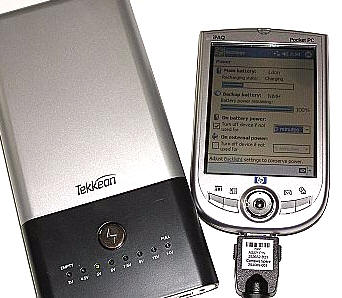
It took from 11:25am to 1:18pm (almost two hours) to completely bring the iPAQ 1945 from "dead in
the drawer" to fully charged. While the back of the iPAQ 1945 did warm
slightly as it was being charged, it never reached the hot temperatures that
my iPAQ 4700 had. At the conclusion of the charging, the iPAQ worked perfectly
and I still had six of the eight green LED lighting up when I checked the
myPower’s available battery reserve.
Therefore, based on this separate iPAQ testing and based on the
information I received from Delta Electronics considering the myPower’s voltage
output, I can only conclude that what happened to my iPAQ 4700 was a terrible
fluke. While I am not prepared to say that there was an inherent problem lurking
in my iPAQ, I feel that it also wouldn’t be fair to say that it was completely
the myPowerALL’s fault that my iPAQ now has an overheating problem. All I can
say for sure is that the combination of the 4700 and the myPowerALL seems
to have triggered a charging/cooling failure in my iPAQ 4700. Hopefully this can
be fixed after I return from vacation.
Read the Tekkeon myPower All’s FAQ
here.
Find the best price for the Tekkeon myPower All Universal Recharger
here.
Price: $119.95
Comes with a one year limited warranty on
Pros:
Worked very well on my Fujitsu laptop
Worked very well on my HP iPAQ 1945
Compact size
Solid unit
Eight different included adapter tips that will fit most electronics with DC jack
Cons:
Appears to have contributed to the triggering of a charging/cooling failure in
my iPAQ 4700
Product Requirements:
Device:
any device with a DC jack
for MagSafe Wallet, Strongest Magnetic Wallet for iPhone 16/15/14/13/12 Series, 7 Cards Holder, Magnetic Phone Wallet, Leather Minimalist Slim RFID for iPhone Wallet, 1 Slot, Black & Black
$19.99 (as of April 20, 2025 17:42 GMT -04:00 - More infoProduct prices and availability are accurate as of the date/time indicated and are subject to change. Any price and availability information displayed on [relevant Amazon Site(s), as applicable] at the time of purchase will apply to the purchase of this product.)QYQBOON Mag-Safe Wallet Magnetic Wallet for iPhone Lightweight Magnetic Phone Wallet Stand Adjustable Leather Magnetic Card Holder for iPhone 16/15/14/13/12 Series, Not for iPhone 13/12 Mini (Black)
24% OffProduct Information
| Price: | 119.95 |
| Manufacturer: | Tekkeon |
| Pros: |
|
| Cons: |
|


